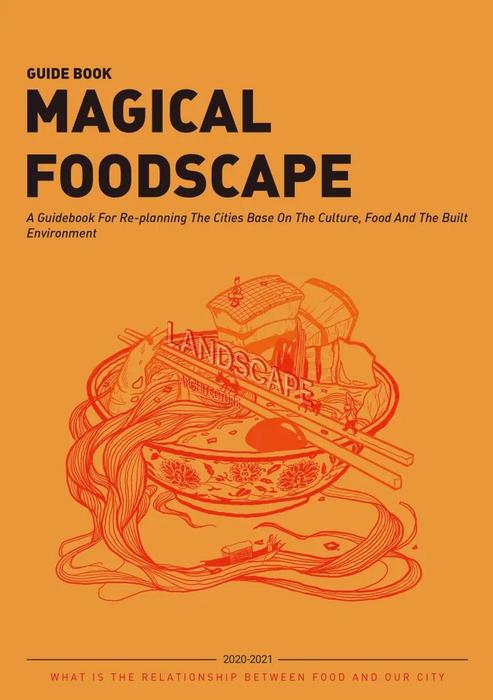Agriculture, fishing, hunting, and gathering— through thousands of years of urbanization, these ways of acquiring food, which were deciding factors in settlement landscape patterns in the primitive society, have gradually been replaced by the manufacturing, financial, and service industry. Nowadays, urban planning seems to have lost its connection with food.

Credit: Shen X (2024) Magical Foodscape: A Guidebook For Re-planning The Cities Base On The Culture, Food And The Built Environment. Advanced Books, Pensoft, Sofia, 1-148.
Agriculture, fishing, hunting, and gathering— through thousands of years of urbanization, these ways of acquiring food, which were deciding factors in settlement landscape patterns in the primitive society, have gradually been replaced by the manufacturing, financial, and service industry. Nowadays, urban planning seems to have lost its connection with food.
A new book, Magical Foodscape: A Guidebook For Re-planning The Cities Base On The Culture, Food And The Built Environment by Xiwei Shen of the University of Nevada, explores the many ways in which food and urban spaces are linked. “Under the COVID-19 epidemic, the common problem faced by different countries and regions—food shortage, inspired us to reflect on the place of food in urban life,” Shen says.
His research focused on four Chinese cities, Chengdu, Xi’an, Wuhan and Shanghai, all of them characterized by different and distinctive food culture. With a team of students from multiple cities, all working online collaboration during the pandemic, he explored the distribution patterns and potential of grain origin, delivery chains, processing chains and retailers in each of the four cities.
Urban green space, he believes, can be used to improve the efficiency of food production, absorption, and processing, promoting the circulation of both food and culture. This solution also has the potential to alleviate food problems in social crises and improve the cities’ ability to respond to social emergencies via what Shen calls “the foodscape.”
Magical Foodscape offers diverse planning guidelines based on the distinctive culture, food, and environment of the four iconic cities. It explores each city’s unique culinary landscape in detail, providing tailored strategies to address local challenges and opportunities. Available to download for free and published by Pensoft, Magical Foodscape offers useful guidelines to a wide range of actors. For example, it can serve as a gastronomical tourist guide, advise restaurant owners on the best place to open their establishments, or even inform the policy strategies of local and national governments. It also includes “food maps” for each city that invite readers to join the campaign and promote the positive development of cities through changes in their daily eating habits.
Chengdu: integrating traditional cuisine with urban efficiency
In Chengdu, terrace patches along rivers can be utilized to optimize the production-processing-supply chain of traditional cuisine, aiming to maximize profit while addressing significant waste issues. Three of Chengdu’s culinary highlights—hot pots, skewers, and teahouses—are facing serious waste problems. “As for hot pots, we proposed the concept of an ’urban farm,’ since traditional cooking methods provide conditions for the reuse of hot pot food waste; as for tea, we proposed to use waste tea as raw material for water purification devices and tea field fertilizers,” Shen says. “We found that the three types of restaurants with large passenger flow in Chengdu were mostly distributed along the terraces of the rivers. We combined the patches along the rivers with food production and food processing to improve the development of the high-efficiency cities.”
Xi’an: transforming food waste into cultural and ecological assets
The research team aimed to solve Xi’an’s food waste problem and use the resulting landscape as a medium to activate local culture. “We propose to establish the concept of ‘food funding’ and encourage ‘new means’ to turn the ecological problems caused by food waste or food packaging into opportunities to solve the existing ecological problems, build community gardens, and support the management of stray animals. At the same time, the resulting landscape activates the hidden special cuisine in Xi’an city and forms a food loop to meet the needs of tourists and residents for entertainment. On the city scale, the ‘food loop’ connects the cultural tourism within the city with the ecological tourism around the city as to promote urban development and optimize the ‘green pattern’,” says Shi.
Wuhan: enhancing urban resilience through green spaces and food
The study of Wuhan, the city of China’s earliest outbreak of COVID-19, reflects the lessons learned during the outbreak and uses geospatial data analysis to establish a scientific emergency mechanism. “Food production space and green space have similar functions in epidemic prevention and control,” Shi says. For example, arranging green spaces evenly helped shorten the distance for people to move, in order to reduce the spread of the COVID-19 disease in the early stage of the virus outbreak.
Shanghai: revitalizing traditional Chinese cuisine through urban planning
“We aimed to take the advantage of the processing methods and marketing models of Shanghai’s traditional gastronomy to revive Chinese restaurants by re-planning the city’s food pattern via the traditional Chinese cuisine,” Shi explains. His team studied catering efficacy, consumer efficacy and restaurant efficacy, combining their findings with geospatial data and mathematical modeling, to see how Shanghai’s vibrant culinary scene can help revive traditional Chinese restaurants through strategic urban planning.
Food as a catalyst for urban development
Magical Foodscape introduces food as a necessary element of urban planning. Moreover, it shows how food can be used to solve urban problems and optimize spatial structure in cities. “We hope that professional planners can rethink the role of food in guiding urban planning and promote the organic integration of city and food in different cities and revive the food industry,” Shi says in coclusion.
The research also highlights the relationship between food and urban resilience, particularly in the face of crises like COVID-19.
Original source:
Shen X (2024) Magical Foodscape: A Guidebook For Re-planning The Cities Base On The Culture, Food And The Built Environment. Advanced Books, Pensoft, Sofia, 1-148.



